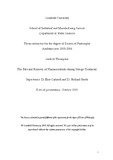JavaScript is disabled for your browser. Some features of this site may not work without it.
| dc.contributor.advisor | Cartmell, Elise | |
| dc.contributor.advisor | Stuetz, Richard | |
| dc.contributor.author | Thompson, Andrew | |
| dc.date.accessioned | 2014-06-13T11:09:12Z | |
| dc.date.available | 2014-06-13T11:09:12Z | |
| dc.date.issued | 2005-10 | |
| dc.identifier.uri | http://dspace.lib.cranfield.ac.uk/handle/1826/8539 | |
| dc.description.abstract | Pharmaceuticals, personal care products and their metabolites are continuously entering the environment through many routes, especially from the effluent of sewage treatment plants. The aim of this work was to examine the fate and removal of pharmaceuticals during sewage treatment, and establish ways in which current sewage treatment technologies could be optimised to improve removal. Based on an analysis of pharmaceutical usage and environmental effects, four compounds were selected for further study (triclosan, tetracycline, carbarnazeptrine, and caffeine). Reliable analytical methods Were developed, using . HPLC-UV, to detect these compounds in sewage samples. The amounts of removal of the four compounds were quantified using laboratory sorption and biodegradation tests. Both tetracycline and triclosan were shown to be readily biodegradable, and to sorb strongly to biomass, although sorption occurred at different rates. Caffeine degraded rapidly, but did not sorb to biomass, whilst carbarnazepine did not sorb or biodegrade. Grab samples were taken before and after every major process unit at four sewage treatment plants (STPs). Although tetracycline was not detected in any samples, triclosan was measured at concentrations up to 5115 rig I-1, caffeine was measured at concentrations up to 82,300 ng C., and carbarnazeptne was measured at concentrations up to 1461 rig 1-1. This is the first time carbarnazepine and caffeine concentrations have been reported in UK sewage. The grab samples showed that a wide range of pharmaceutical effluent concentrations can be expected. The concentrations of the pharmaceuticals detected in this research were not high enough to cause immediate harm (i.e. death) to aquatic organisms. However, there is insufficient information to determine whether exposure to these low concentrations, typically around PNEC levels, may have an effect over a long period of time. Further composite sampling conducted at one STP generated data, modelled using Toxchem-1-, which demonstrated how variations in a wide range of parameters were correlated with the removal of pharmaceuticals. These showed that whilst sludge age may be the most important parameter, pH, temperature, hydraulic retention time, and chemical oxygen demand could have a critical effect on the removal of pharmaceuticals. Several ways of optimising sewage treatment plants have been proposed, including pH adjustments and longer HRTs to enhance sorption, as well as a novel adaptation to activated sludge tanks incorporating two WAS type bioreactors to enhance biodegradation. The effects of plant operating events, such as aeration failures, were also investigated. These showed that a typical length of aeration loss (four hours) could result in reduced pharmaceutical removal (through decreases in both sorption and biodegradation) for up to twelve hours. Overall, this work has shown that it may be possible to adapt current sewage treatment technology to improve removal of pharmaceuticals which sorb or biodegrade readily. With further research, these adaptations could become a viable alternative to tertiary treatment technologies such as ozonation, granular activated carbon, or chlorine dioxide | en_UK |
| dc.language.iso | en | en_UK |
| dc.publisher | Cranfield University | en_UK |
| dc.rights | © Cranfield University 2005. All rights reserved. No part of this publication may be reproduced without the written permission of the copyright holder. | en_UK |
| dc.title | Fate and removal of pharmaceuticals during sewage treatment | en_UK |
| dc.type | Thesis or dissertation | en_UK |
| dc.type.qualificationlevel | Doctoral | en_UK |
| dc.type.qualificationname | PhD | en_UK |
